Decades on, bacterium’s discovery feted as paragon of basic science

Tom and Kathie Brock enjoy the 140 acres of restored prairie, oak savannah and woodlands that they established as the Pleasant Valley Conservancy in Black Earth.
Over time, the esoteric and sometimes downright strange quests of science have proven easy targets for politicians and others looking for perceived examples of waste in government — and a cheap headline.
In 1966, microbiologist Tom Brock‘s National Science Foundation-supported treks to Yellowstone National Park to study life in the park’s thermal springs might easily have been singled out as yet another feckless science project, deserving of a “Golden Fleece Award.”
But Brock, then a professor at Indiana University, and Hudson Freeze, an undergraduate student working with Brock at Mushroom Spring in the Lower Geyser Basin of Yellowstone, found something that by any measure validates investments in basic science, the undirected search for new knowledge.
At the time, Brock was simply interested in studying the microbial ecology of the thermal springs that make Yellowstone famous. It was a frontier of knowledge as scientific dogma held that life, or at least photosynthetic life, could not occur at temperatures above 160 degrees Fahrenheit.
Brock’s discovery set the stage for the branch of science that studies life in extreme environments and, most tangibly, yielded an enzyme that is central to the technology for amplifying DNA — revolutionizing everything from medical diagnostics to criminal forensics.
But to their astonishment, Brock and Freeze found a bacterium, later dubbed Thermus aquaticus, that made its entire living in the scalding waters of Mushroom Spring. The discovery set the stage for the branch of science that studies life in extreme environments and, most tangibly, yielded an enzyme, Taq polymerase, that is central to the technology for amplifying DNA — revolutionizing everything from medical diagnostics to criminal forensics.
“We were looking for a simple system where one could do basic research in microbial ecology. Everything fell out of that,” recalls Brock, now an emeritus professor of bacteriology at UW–Madison. “We didn’t know there were these organisms that could live in boiling water.”
Now, almost 40 years after discovering and describing the organism, Brock and Freeze are being recognized with the Golden Goose Award, an award aimed at celebrating “seemingly obscure studies that have led to major breakthroughs and resulted in significant societal impact.”
Conferred by a gaggle of organizations — the American Association for the Advancement of Science, the Association of American Universities, the Association of Public and Land-grant Universities, the Breakthrough Institute, the Progressive Policy Institute, the Science Coalition, the Task Force on American Innovation, and United for Medical Research — the Golden Goose Award is given for federally-funded research that has led to “demonstrable, significant human and economic benefits.”
“Off-the-wall science yields medical miracles. We can’t abandon research funding only because we can’t predict how the next miracle will happen.”
Jim Cooper
The enzyme derived from the Thermus aquaticus bacterium powers polymerase chain reaction, or PCR. It is a technique used routinely to take trace amounts of DNA and amplify it for identification or study. The Taq polymerase is useful because it is stable at the high temperatures PCR requires to denature DNA and exponentially replicate target strands. The technology — for which its inventor, Kary Mullis, was awarded the Nobel Prize — is widely used in molecular biology, criminal forensics and medical diagnostics.
The Golden Goose Award was originally conceived by Congressman Jim Cooper of Tennessee to help educate members of Congress and the public about the value of basic scientific research. The name is a play on the Golden Fleece Awards, given by the late Wisconsin Sen. William Proxmire between 1975 and 1988, targeting specific federally funded research grants as examples of government waste.
“We’ve all read stories about the study with the wacky title, the research project from left field,” Cooper says. “But off-the-wall science yields medical miracles. We can’t abandon research funding only because we can’t predict how the next miracle will happen.”
Taq polymerase has gone on to be a workhorse molecule of science in good measure because Brock and Freeze deposited samples of the organism in the American Type Culture Collection, a repository where others can freely obtain cultures of the organism for little or no cost. It was there that Mullis and his collaborators found Thermus aquaticus and its enzyme when they were looking to replace an E. coli enzyme that did not survive the high temperatures of PCR.
Although Brock began his career at the Upjohn Co. looking for new antibiotics, after a few years he turned to the professor business and basic research: “Everything I ever did was basic,” says Brock. “It’s great that this discovery happened, but I wouldn’t have predicted it.”
Brock and Freeze will receive their award at a Capitol Hill ceremony on Sept. 19.
Tags: biosciences, research



